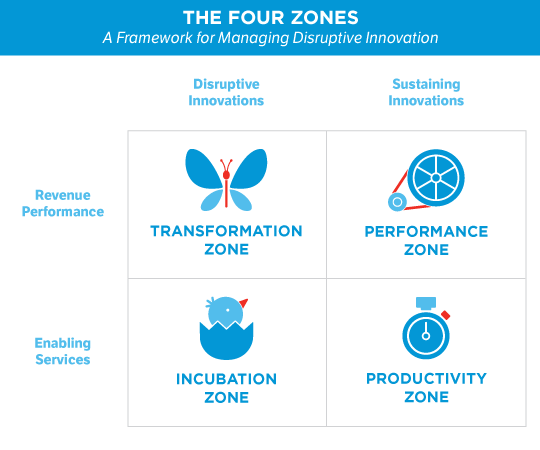
How should a middle market company cope with disruptive threats to its business? In a previous post, Disruption Demystified, I identified four basic strategic approaches a mid-sized company can take:
- Visionary: Become the disruptor yourself, allied and aligned with the forces disrupting your industry. This is the boldest course.
- Pragmatists in Pain: Neutralize disruption by adopting some of its features while protecting your core business. This is a strong defensive posture.
- Pragmatists with Options: Do not lead change but keep abreast of it, modernizing as new approaches are proven. This is the default strategy for a business not immediately in danger.
- Conservative: Delay as long as you can, adopting new technologies only when they are commoditized. A strategy of delay can be viable--but not one of denial.
Having weighed the pros and cons of the various options, and having reached a decision as to which you will choose, you are left with a critical question to answer “How can we organize to give ourselves the best chance to execute our strategy successfully?” This is a particularly important question to a middle market enterprise that has high sensitivity to the risk of jeopardizing its very future. Transformational changes are exceptionally challenging, and it is hard to know how to allocate resources between them and the demands of ongoing operations. In my work with companies of all sizes, I have developed straightforward framework designed to help you make these decisions:

This framework is based on two principles:
- Disruptive innovations (which involve new technologies, new markets, and new business models) need to be managed in a categorically different manner than sustaining innovations (which, however “new” they are, do not fundamentally change the business).
- Innovations that have a material impact on current revenue need to be managed in a categorically different manner than back-office services and experimental initiatives.
Applying these two principles organizationally results in four zones of activity, each with its own mission, each with its own management playbook. Three of these zones are more or less permanent; one—the Transformation Zone—is transitory. All are critical to managing successfully in an age of disruption. Here is how it plays out:

- The Performance Zone. This is the zone responsible for making an impact on the outside world. It is the anchor point for your established lines of business. It is made up of the people who sell what you make and who make what you sell—everyone, in other words, who has a number to hit. The sales teams are accountable for delivering forecasted bookings quarter after quarter, the product teams for delivering forecasted revenue, again quarter after quarter. The three other zones in one way or another are funded by, and are in service to, this zone. This is your economic flywheel, and you break its cadence at your peril. You want it led by a team that is execution oriented, competitive, and quick to respond. That said, for those very characteristics, this leadership team will likely be resistant to disruptive change because such a challenge inevitably takes resources away from them and allocates them to other parts of the business.

- The Productivity Zone. This is the zone that does all the behind-the-scenes work. The organizations here—finance, HR, marketing, purchasing, et cetera—are cost centers that do not have a number to make, but they provide a wide variety of back-office and front-office functions and services essential to completing your value delivery and complying with the regulations that govern your industry. Leaders in this zone have two main levers to pull—programs designed to intervene in situations to change behavior and improve effectiveness, and systems designed to stabilize situations to secure compliance and improve efficiency. The former calls for a leadership team with a high degree of collaboration, the latter for one with a high degree of discipline. Again, for these very characteristics, this zone too is likely to resist disruptive innovation as it can destabilize the very operating ratios its leaders are trying to hold constant.

- The Incubation Zone. This is the zone where you experiment with disruptive innovations that have the potential to impact the operating model of the Performance Zone or the infrastructure of the Productivity Zone. It is deliberately sequestered from these two zones for that very reason, as well as to allow its operations to be more agile and flexible. It often has no formal organization, grouping instead around specific projects, typically staffed with cross-functional team members who have been seconded from their normal duties. Its goals are to learn fast, prototype quickly, get smart, throw out the chaff, and champion the wheat. All this is done at a relatively small scale so, win or lose, it does not have a material impact on current financial performance. Teams in this zone follow the beat of a different drummer—that is their reason for being. The danger is they may develop a false sense of superiority to colleagues in other zones, thereby activating antibodies that counter-attack the disruptions they are trying to advocate, all of which makes onboarding any of their innovations just that much more challenging.

- The Transformation Zone. This is not a persistent zone in your organization. It comes into existence only during a time of great change and does so for one purpose—to manage your company through a disruptive transition that poses a material risk both to present operations and the future viability of the firm. This could include onboarding a disruptive innovation into your core offerings, entering a brand new market, assimilating a major acquisition, or fighting for your life against a next-generation market disrupter. Regardless of the source of the disruption, these kinds of transformation call for a radical reallocation of resources to meet the new demands. This can only be affected by the CEO; no one else in the enterprise has the power and the prestige to pull this off. Specifically, the call to action is to lead directly in a hands-on way until the tipping point of change is reached and the crisis is past. At that point the Transformation Zone ceases to exist, and the enterprise can establish a “new normal” on the other side of change. Until then, however, under no circumstances can responsibility for this zone be delegated: The CEO must own it.
So those are the four zones. The Performance Zone and Productivity Zone are the bedrock of any established enterprise; the Incubation Zone is showing up in more and more companies as they realize how impactful digital innovations are going to be; and the Transformation Zone remains a work in progress even in the best of families. That said, note that each zone has a distinct playbook: It has a different funding contract, a different set of deliverables, a different set of metrics, and a different leadership style and mandate. This is why the discipline of zoning itself is so important. You do not want leaders in any one zone applying their metrics and dictating terms to leaders in the other three. Instead, you want the first three zones to get along relatively harmoniously in undisrupted times, and you want all three to take their lead from the Transformation Zone in times of crisis.
With that in mind, let’s apply the zone framework specifically to the execution of a technology adoption strategy and see how a company would execute each of the four bets one can make. Here’s how it plays out:
- When a disruptive innovation that has the potential to directly impact your business comes into view, initiate if you have not already an Incubation Zone, and charge it to learn about and experiment with the new technology. Put some urgency behind the project. Based on what you learn from its efforts and what you know of your own industry and your own enterprise’s aptitude for change, you can decide which of the four bets you want to make.
- If you decide to make the conservative adoption bet, your goal is to channel the innovation directly into your Productivity Zone, without disrupting the Performance Zone at all. This might mean, for example, asking the head of your Information Technology team to transition a suite of existing systems to the cloud with minimum impact on the rest of the company. In other words, you want to make changes to your infrastructure model that do not require re-engineering your current operating model. You just want your existing operations to become more efficient.
- If you are making the pragmatist with options bet, you do want to the new technology to impact your operating model. That is, you want it to make your day-to-day business operations not only more efficient but more effective as well, say by creating some mobile applications that let your customers, partners, or employees access your services more conveniently. Such a project needs to be directly sponsored by the leader of those operations, a senior executive from the Performance Zone--specifically the person to whom the bulk of the people who must change their ways currently report. This leader will be accountable for both making his or her assigned numbers in the current annual plan and successfully converting operations to the new system. The IT team in the Productivity Zone can support this by program managing the effort, but since IT lacks the clout to hold end users accountable for adopting the new system, executive sponsorship must come from the line-of-business side of the house.
- The stakes are much higher when it comes to making the pragmatist in pain bet. Now you must reengineer an existing operating model at high speed because it is under direct attack. The good news is you do not need to invent some amazing new form of differentiation. You just need to incorporate enough of the new approach to catch up. In effect, you are not overthrowing your current operating model—you are modernizing it. Nonetheless, this is going to generate a lot of resistance from the Old Guard, and given that the future of the franchise is at stake, the CEO must intervene. This means activating the Transformation Zone as a project-driving mechanism to accelerate the response, in part by giving the Performance Zone relief from its operating targets while the change is being put in place. Only a CEO can grant this sort of reprieve, and the sooner the business can get back to business, the better.
- Finally, when it comes to executing the visionary bet, an all-hands-on-deck effort is required, and again it can only be led by the CEO, operating out of the Transformation Zone. Here the very size of this bet puts the future of the enterprise in play, and seeing it through to completion is critical to the safety of the franchise. Once again, that means in the short term committed performance metrics may need to be sacrificed in order to achieve a future larger gain. This is simply a matter of prioritization, and nothing takes a higher priority than a Transformation Zone initiative.
To sum up then, when mid-market companies are faced with the prospect of disruptive innovations entering their business sector, the sort of thing that digital technology promises to bring to every sector of our economy sooner or later, leadership teams need to organize to compete effectively while remaining true to their culture, customers, and brand. The four bets and the four zones are frameworks to help teams select the strategy best for them and to execute that strategy with a high probability of success. By using these frameworks executives can create a common vocabulary to help everyone in the enterprise understand the changes that are under way and align to support them. To learn more about the four zones, see my latest book, Zone to Win and hear my chalk talk about the book.
About the Author
Geoffrey Moore is an author, speaker, and advisor who splits his consulting time between start-up companies in the Mohr Davidow portfolio and established high-tech enterprises, most recently including Salesforce, Microsoft, Intel, Box, Aruba, Cognizant, and Rackspace.
Moore has a bachelors in American literature from Stanford University and a PhD in English literature from the University of Washington. After teaching English for four years at Olivet College, he came back to the Bay Area with his wife and family and began a career in high tech as a training specialist. Over time he transitioned first into sales and then into marketing, finally finding his niche in marketing consulting, working first at Regis McKenna Inc, then with the three firms he helped found: The Chasm Group, Chasm Institute, and TCG Advisors. Today he is chairman emeritus of all three.